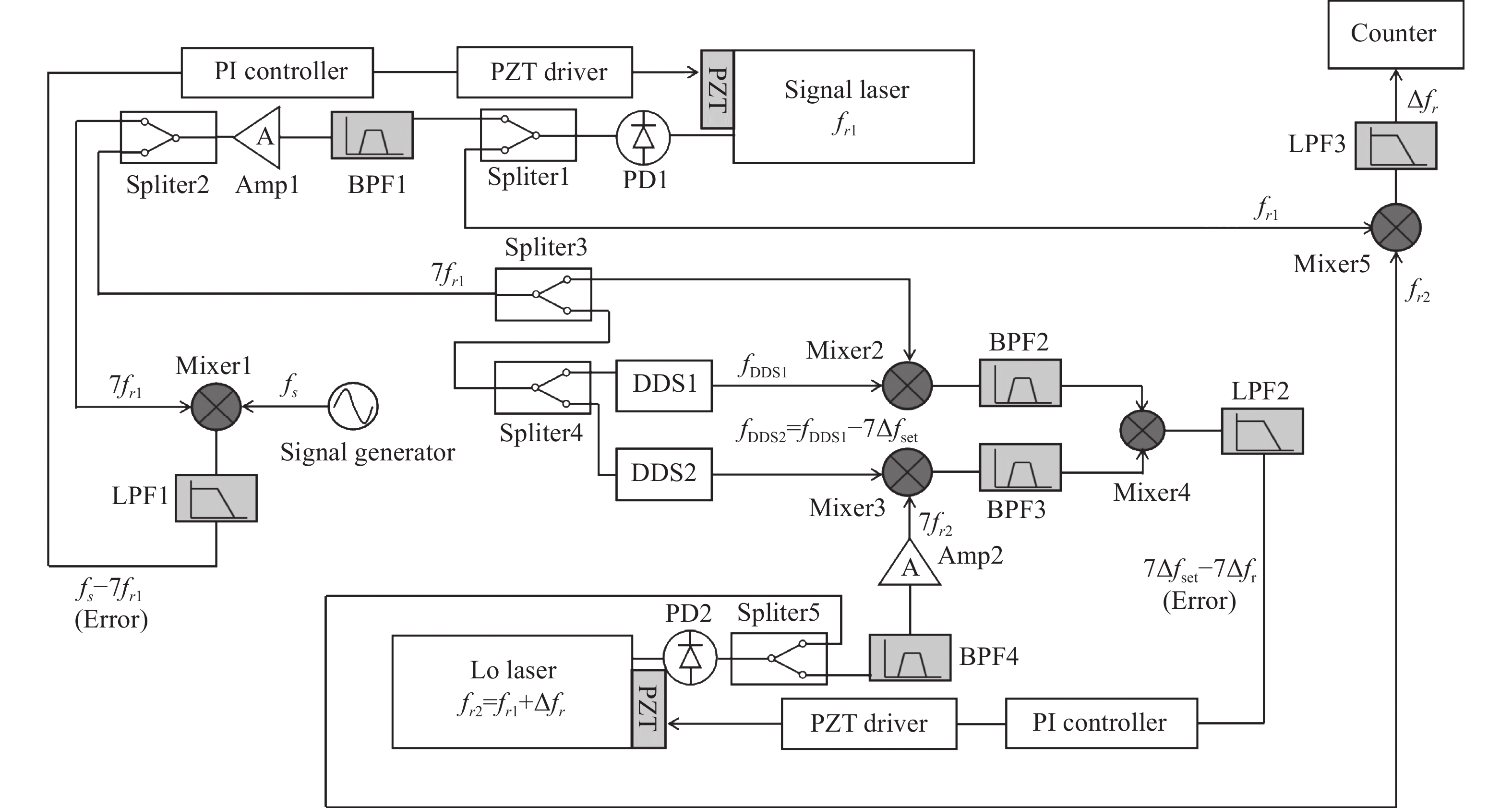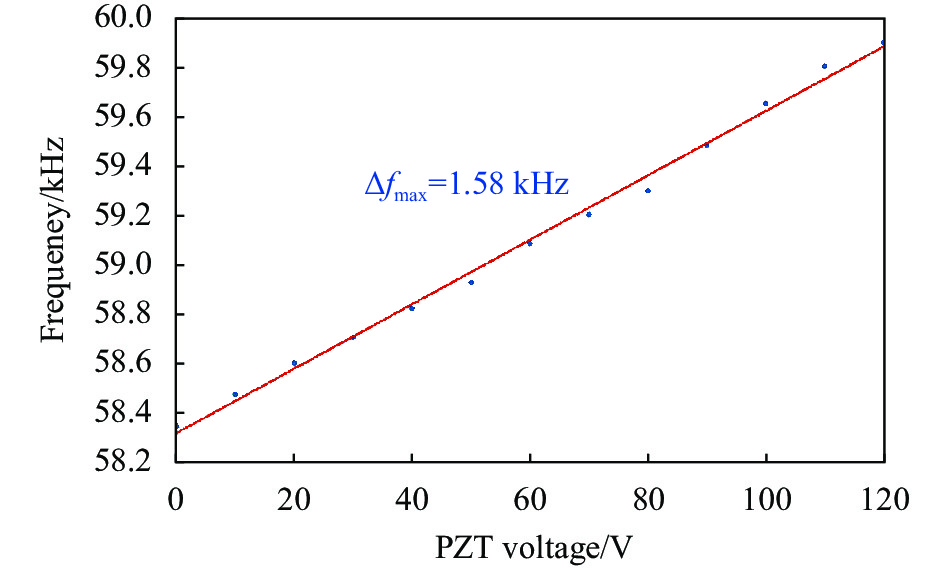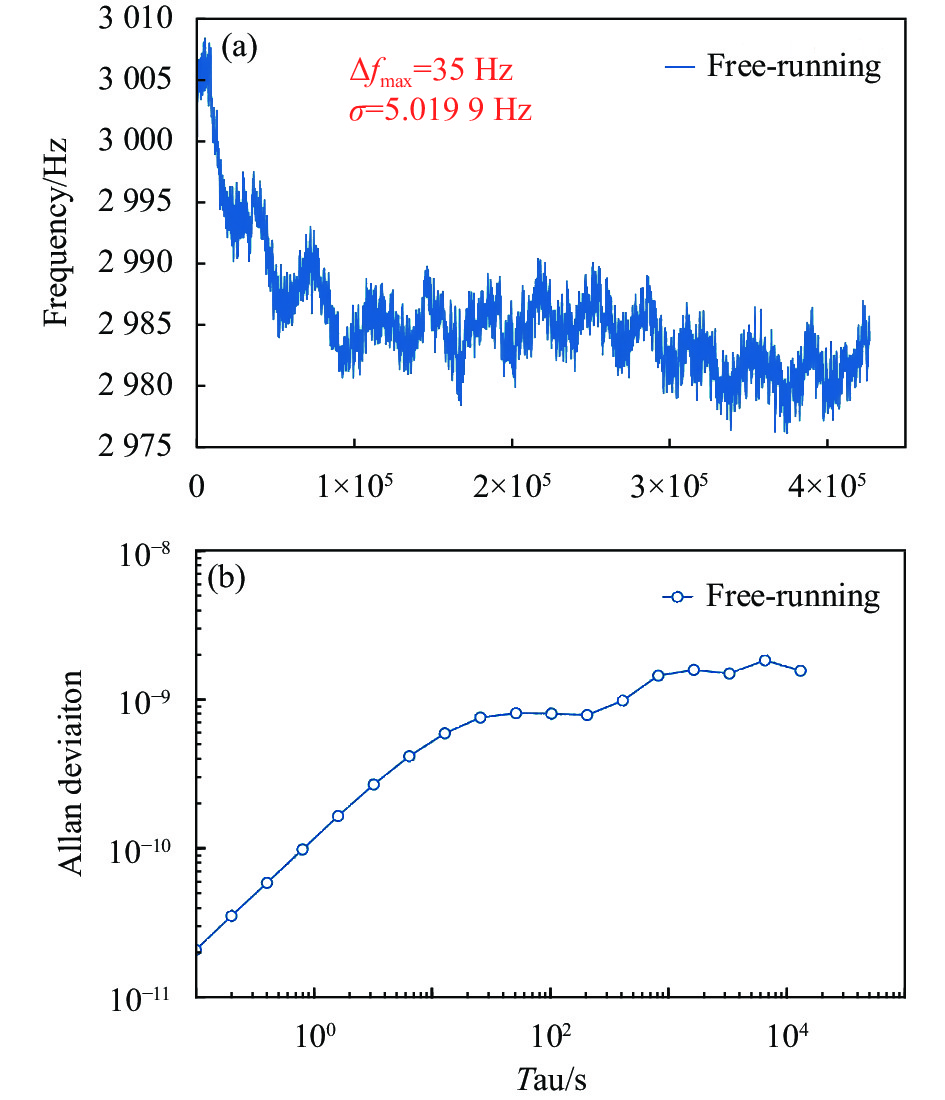-
飞秒激光频率梳是基于飞秒脉冲激光器产生的,它在时域上表现为时间间隔相等的脉冲序列,而在频域上则是表现为数以万计的频率间隔相等的“梳齿”的集合。飞秒激光频率梳自20世纪末期诞生以来,由于其优秀的时频特性,在时频传递[1]、通信[2]、绝对距离测量[3-4]、精密光谱学[5]、相位噪声探测[6]以及高精度高分辨激光雷达[7-8]等领域都有着重要的应用。2009年,美国标准计量局(NIST)的Coddington博士[9]提出双光梳异步光学采样测距方法,采用两台具有微小重复频率差的飞秒激光频率梳分别作为测量光梳以及本振光梳来构建测距系统。在测量过程中,本振光梳与测量光梳之间的重复频率差决定了异步光学采样的密度,重复频率差的不确定度会影响距离测量的精度[10],因此重复频率差的锁定具有非常重要的意义。
目前,飞秒激光频率梳重复频率与重复频率差的锁定一般是采用锁相环技术[11]控制飞秒激光器谐振腔的腔长或者是控制激光谐振腔内传输介质的折射率这两种方案[12]。其中谐振腔腔长的改变是通过改变压电陶瓷(PZT)的驱动电压来实现,激光腔内传输折射率的改变则是通过在腔内加入电光调制器(EOM)来实现。双光梳系统中重复频率差的锁定目前大多是通过将两台飞秒激光器分别锁定到由同一个高精度的外部信号参考源联系起来的两台高精度高输出频率的信号源上来实现,2016年,徐昕[13]等人就利用这种方案对双光梳系统重复频率差进行锁定,锁定后重复频率差稳定度在平均时间1 s内达到了4×10−12。但这种方案的锁定噪声较大,且需要一台高精度的共同参考源以及两台高精度高输出频率的信号源,价格昂贵,体积也比较庞大。2021年,Hu[14]等人提出了一种自由运转的双波长双光梳光源,不需要进行锁相,重复频率差在30 min内的漂移范围为0.79 Hz,标准差为0.14 Hz。这种方法虽然可以输出具有一定稳定度的重复频率差的双光梳,简化了系统结构,但是重复频率差稳定度具有一定的局限性,不利于双光疏系统在纳米量级精度的精密测量,且双光梳的波长不同,需要非线性放大和滤波装置。
文中设计了一种双光梳重复频率差异步锁定技术,利用一台高精度高输出频率信号源以及两台数字信号发生器,结合滤波器、混频器、压电控制器和伺服控制器实现了对双光梳系统的重复频率差进行精密锁定,锁定后重复频率差在1 s的平均时间内稳定度达到了1.8×10−13,且锁定噪声比使用两台高精度高输出频率信号源进行独立锁定的方法要低,在锁定精度提高的同时,大幅降低了成本,为利用双光梳系统在工业领域进行绝对距离测量打下了坚实的基础。
-
光学频率梳的本质是一种超短脉冲锁模激光器[15],如图1所示,其输出的超短脉冲在频域上表现为一系列具有严格等间距的脉冲序列,像一根根的“梳齿”一样。相邻两个脉冲之间的频率间隔就称为输出脉冲的重复频率
$ {f_r} $ ,而激光器的输出脉冲由于受到腔内外部各种噪声的影响,会使得脉冲序列会有一个整体的偏移,称为脉冲的载波包络偏移频率$ {f_0} $ ,因此在光学频率梳中,其重复频率为:式中:
$c$ 为光速(真空);$n$ 为激光器谐振腔内的折射率;$L$ 为激光器谐振腔的长度。 每一根频率梳齿就可以表示为:式中:
${f_k}$ 为第k根梳齿的频率;$k$ 为正整数;$ {f_r} $ 为重复频率;$ {f_0} $ 为载波包络偏移频率。在时域上,如图2所示,光学频率梳表现为一系列周期
$ T $ 为$ {1 \mathord{\left/ {\vphantom {1 {{f_r}}}} \right. } {{f_r}}} $ 的脉冲序列。从时域上可以更加直观和形象的理解光梳,其中$ \vartriangle\varphi $ 为载波包络相位差,与频域中的载波包络偏移频率$ {f_0} $ 相对应,表示由于腔内色散等因素的影响,包络与载波的相对相位关系会出现细微改变。在双光梳测距系统中,可以利用飞行时间法[16]求得待测绝对距离
$D$ 为:式中:
$\Delta T$ 为参考与测量脉冲之间的时间延迟;$\Delta {f_r}$ 为双光梳重复频率差。从公式(3)可知,若重复频率差的稳定性很差,则测距的精度会大大降低,为了得到精确的测距结果,必须要对双光梳系统中的重复频率差进行锁定。锁定重复频率差与锁定重复频率的原理是相同的,由公式(1)可知,激光器的重复频率与谐振腔的等效腔长以及腔内介质的折射率有关,故可以通过控制腔长或者折射率来达到锁定重复频率的目的。在文中的双光梳系统中,重复频率差的锁定部分主要是通过控制谐振腔的腔长来实现的。实验中,将PZT固定在反射腔镜上,通过改变作用在PZT上的加载电压而改变自由空间光传输距离(即谐振腔等效腔长),从而达到控制重复频率的目的。
-
文中设计的双光梳重复频率差异步锁定装置如图3所示,包括光学系统和电学系统两部分。光学部分包括重复频率
${f_{r1}}$ 为155.711 MHz的信号光梳、重复频率${f_{r2}}$ (${f_{r2}} = {f_{r1}} + \Delta {f_r}$ )为155.714 MHz的本振光梳(即重复频率差$\Delta {f_r}$ 为3 kHz)以及谐振腔内的PZT;电学系统部分主要是基于商用器件搭建而成,包括了光电探测器(PD)、功分器(Spliter, mini circuits FSC211等)、混频器(Mixer, mnicircuits ZFM150等)、带通/低通滤波器(BPF/LPF, Minicircuits BPF1090及BLP-5等)、放大器(Amp)、高精度信号发生器(Signal generator, R&S SMB100A)、数字信号发生器(DDS, Analog devices AD9912)、伺服控制器(PI Controller, New focus LB1005)、压电驱动器(PZT driver, 芯明天E00.C3)和频率计数器(Counter, Keysight 5323A)等。如图3所示,光电探测器PD1将探测到的信号光梳的重复频率及其高次谐波转换为电信号输出到带通滤波器BPF1中,利用带通滤波器提取出其七次谐波信号
$7{f_{r1}}$ ,即1.09 GHz,这受限于所使用的信号发生器(R&S SMB100 A)的上限频率(1.1 GHz)。因为重复频率的高次谐波相比于基频信号具有更多的相位噪声信息[17],但锁相回路在基频(150 MHz附近)和七次谐波(1 GHz附近)的工作性能接近,从而锁定重频的高次谐波可以获得更好的精度。将提取出的重复频率七次谐波信号$7{f_{r1}}$ 经过放大器Amp1放大后与高精度信号发生器输出的信号$ {f_s} $ 通过混频器Mixer1进行混频,用低通滤波器LPF1提取出混频器中的差频信号并输入到PI伺服控制器中生成相应的误差控制信号${f_s} - 7{f_{r1}}$ ,利用这个误差信号经过压电控制器来驱动信号光梳谐振腔内的PZT产生微小形变就可以改变谐振腔的腔长,形成一个闭环的反馈回路,从而实现信号光梳重复频率的锁定。锁定后重复频率与高精度信号发生器输出的频率相等,即${f_{r1}} = {f_s}$ ,并且具有与高精度信号发生器输出频率类似的频率稳定度。锁定了信号光梳的重复频率后,将其重复频率的七次谐波信号作为信号源去触发数字信号发生器DDS1和DDS2,产生两个频率略有差异的信号${f_{DDS1}}$ 和${f_{DDS2}}$ ,其中${f_{DDS1}}$ =137.021 MHz,${f_{DDS2}}$ =137 MHz,而两个信号之间的差值就是预设的双光梳重复频率差的七倍,即$ {f_{DDS1}} - {f_{DDS2}} = 7\Delta {f_{set}} $ =21 kHz(此差值的大小可根据需求通过调整两台DDS信号发生器的输出值来决定);然后再将信号光梳重复频率的七次谐波信号$7{f_{r1}}$ 与经过光电探测器PD2探测并用带通滤波器BPF4提取到的本振光梳重复频率的七次谐波信号$7{f_{r2}}$ 分别与DDS数字信号发生器输出的信号${f_{DDS1}}$ 和${f_{DDS2}}$ 通过混频器Mixer2与Mixer3进行混频,并用带通滤波器BPF2和BPF3滤除Mixer2与Mixer3中的差频信号,保留和频信号,两个和频信号再通过Mixer4进行一次混频,最终利用低通滤波器LPF2提取混频得到的差频信号输入到PI控制器中生成相应的误差控制信号$7\Delta {f_{set}} - 7\Delta {f_r}$ ,利用这个误差信号经过压电控制器来驱动本振光梳谐振腔内的PZT就可以反馈控制谐振腔的腔长,形成一个闭环的反馈回路,使本振光梳重复频率锁定,锁定后重复频率为$ {f_{r2}} = {f_{r1}} + \Delta {f_r} $ 。此时,两台光梳之间的实际重复频率差值与预设的重复频率差相等,即$\Delta {f_r} = \Delta {f_{set}}$ ,实现了双光梳重复频率差的异步锁定。在整个实验装置中,PZT是控制重复频率最重要的一个器件,其影响了整个锁定系统的响应特性以及最大调谐频率。在文中的锁定系统中,选用的PZT是Thorlabs的PK44LA2P2,其驱动电压量程为0~150 V,行程为9 μm。为了测试PZT的重复频率调谐能力,在调节PZT驱动电压的同时,在0~120 V范围内(实验装置中使用的压电驱动器驱动电压范围)测量了重复频率的变化量,如图4所示,实验装置中所选用的PZT可以调谐重复频率的最大范围是1.58 kHz,完全满足自由运转状态下激光器重复频率的变化量。
-
文中的实验部分主要是利用频率计数器来对双光梳重复频率差锁定前后的数据进行记录,并计算其Allan偏差和标准差,以此来评价搭建的双光梳重复频率差异步锁定系统的锁定效果。
图5所示为实验所使用的两台掺Er光纤飞秒激光频率梳在泵浦源功率为650 mW下输出的光谱图。由图5可知,信号光梳的中心波长为1556 nm,3 dB带宽为38.26 nm,本振光梳的中心波长为1550 nm,3 dB带宽为29.69 nm。
如图6(a)所示,在长达约12 h的测量时间里,自由运转的双光梳系统重复频率差由于温度、湿度等外界因素的影响,最大波动范围在35 Hz(小于PZT的1.58 kHz最大频率调谐量)左右,标准差
$\sigma $ 为5.0119 Hz,变化比较大,稳定性较差。通过对频率计数器记录到的数据进行处理,计算出自由运转时重复频率差的Allan方差曲线,如图6(b)所示,在平均时间为1 s时,得到的Allan偏差为9.929×10−11,但随着时间的推移,Allan偏差的值会越来越大,在100 s时达到了8.145×10−10,说明了对重复频率差的锁定是很有必要的。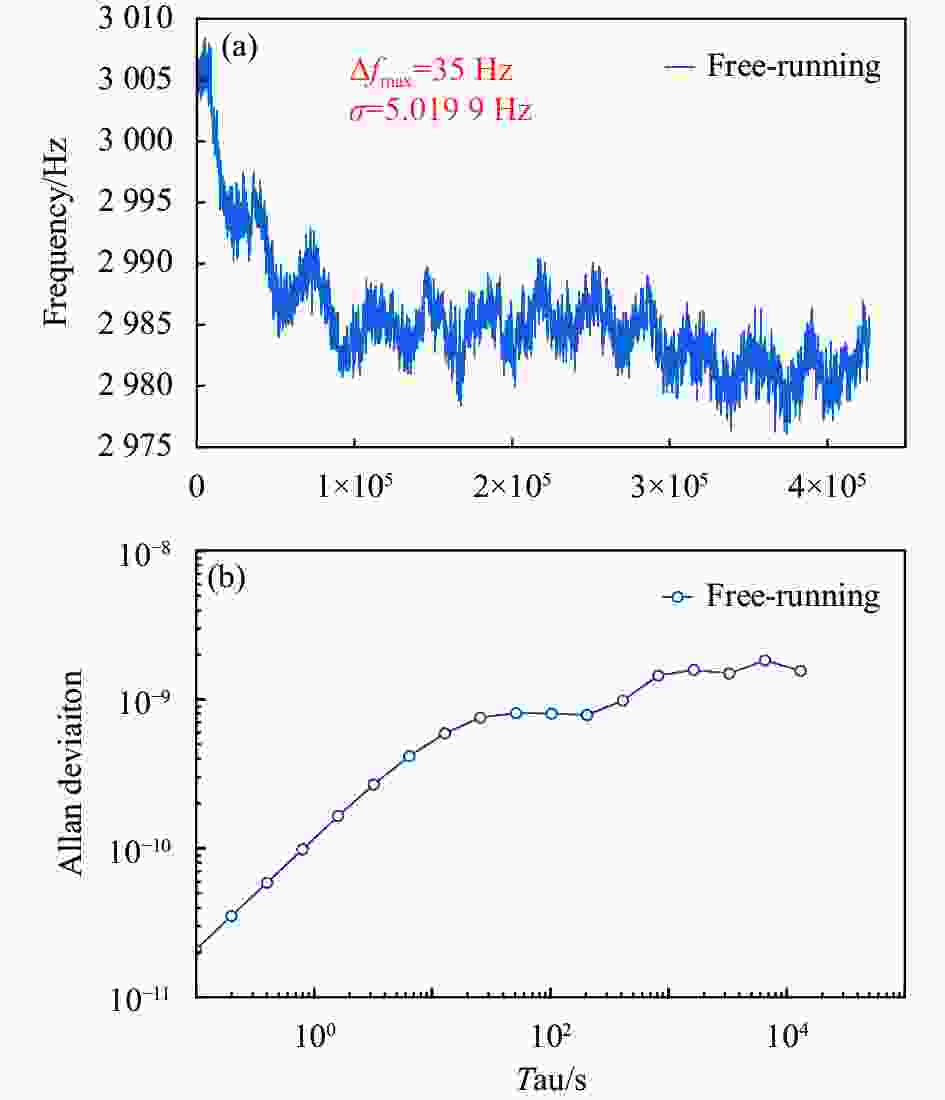
Figure 6. Variation of repetition rate difference and Allan deviation during free-running. (a) Variation of repetition rate difference; (b) Allan deviaition
在进行重复频率差的锁定实验时,首先采用独立锁定方案,通过使用由同一个铷钟作为参考源的两台高精度高输出频率信号源分别对针对两台光梳搭建两套重复频率锁定回路,从而对双光梳系统的重复频率差实现锁定。如图7所示。
经过该方案锁定后的重复频率差信号随时间变化曲线见图8(a),在长达七个小时的时间里,重复频率差的波动范围为6.0263 mHz,标准差为572.05 μHz,相较于自由运转时重复频率差的最大波动范围与标准差均大幅降低。计算出重复频率差经过独立锁定方案锁定后的Allan偏差曲线如图8(b)所示,在平均时间为1 s和100 s时,Allan偏差分别为2.31×10−13和1.901×10−14,比自由运转时候重复频率差的Allan偏差有很大提升。

Figure 8. Variation of repetition rate difference and Allan deviation after independent locking. (a) Variation of repetition rate difference; (b) Allan deviation
而在采用图3所述的双光梳重复频率差异步锁定技术对双光梳系统进行重复频率差的锁定后,同样通过频率计数器对锁定后重复频率差的变化进行跟踪监测,绘制出重复频率差信号随时间变化曲线如图9(a)所示。在监测的七个多小时里,重复频率差的最大波动范围为0.3757 mHz,标准差为40.689 μHz。对比图6(a)所示的自由运转时重复频率差的波动,可以发现重复频率差得到了精密控制,波动范围大幅度减小,且相比于图8(a)所示的独立锁定方案的波动范围以及标准差都要更低。计算出重复频率差经异步锁定技术锁定后的Allan偏差曲线,如图9(b)所示,在1 s和100 s的平均时间内,Allan偏差分别为1.8×10−13和1.579×10−14,比自由运转时重复频率差的Allan偏差提高了大约四个数量级,同时也比经过独立锁定方案锁定后重复频率差的Allan方差有不小的提升,进一步说明了文中所设计的重复频率差异步锁定装置能够实现重复频率差的精密锁定,并且锁定效果比传统的独立锁定方案要更加优异。

Figure 9. Variation of repetition rate difference and Allan deviation after asynchronous locking. (a) Variation of repetition rate difference; (b) Allan deviation

Figure 7. Dual-comb repetition rate difference independent locking scheme with common Rb clock reference
同时,对经过异步锁定后本振光梳的重复频率数据进行了采集,计算其Allan偏差,并与经过独立锁定后的本振光梳重复频率的Allan偏差进行对比,结果如图10所示。由于异步锁定方案得到的误差信号具有更低的残余噪声,所以锁定后本振光梳的重复频率的稳定度也要更高一些。
-
文中采用的双光梳重复频率差异步锁定技术不再采用传统独立锁定方案中使用一个共同参考源来联系两个价格昂贵的高精度信号源的设计,仅采用一个高精度信号源作为整个系统的参考源并利用两个低成本的输出频率较低的DDS数字信号发生器作为异步信号的产生机制,在大大降低锁定系统成本的同时,实现了双光梳重复频率差的精密锁定。在长达七个小时的锁定时间内,最大波动范围为0.3757 mHz,标准差为40.689 μHz,Allan偏差在1 s的平均时间内达到了1.8×10−13量级,各项频率稳定度评价指标较锁定前均有大幅提高,且锁定效果相比于传统的独立锁定方案也有很大提升。经过锁定后的双光梳系统可以满足后续进行双光梳测距的要求。但由于文中所述方案采用的是PZT去控制重复频率的方案,该方案存在需要高驱动电压、易受环境扰动的影响等缺点,会影响重复频率差的稳定度,未来还可以有针对性的优化系统方案,实现更长时间、稳定度更高的锁定。
Research on repetition rate difference asynchronous locking technique of dual-comb
doi: 10.3788/IRLA20220108
- Received Date: 2022-02-15
- Rev Recd Date: 2022-03-10
- Accepted Date: 2022-03-30
- Publish Date: 2022-11-30
-
Key words:
- dual-comb /
- repetition rate difference locking /
- asynchronouslockingtechnique /
- phase-lockedloop /
- frequencystability
Abstract: The dual-comb system has its unique advantages and broad development prospects in the fields of high precision absolute distance measurement, 3-D imaging and spectral measurement. In this paper, an asynchronous locking technique based on phase-locked loop principle was proposed, which can precisely lock the repetition rate difference in dual-comb system. In the experiment, a dual-comb system with a repetition rate of about 155.711 MHz and 155.714 MHz was adopted. By controlling the driving voltage of PZTs through feedback, the length of the laser resonator was controlled to achieve the locking of the repetition rate difference, and the frequency counter was used to collect the data of the repetition rate difference after locking. Allan deviation and standard deviation were used as evaluation indexes of frequency stability. Finally, within the average time of 1 s, the Allan deviation of repetition rate difference was 1.8×10−13, and the jittering standard deviation was 40.689 μHz. The results show that this technology can adjust the repetition rate difference flexibly, and has the advantages of high locking accuracy and strong disturbance rejection.




















































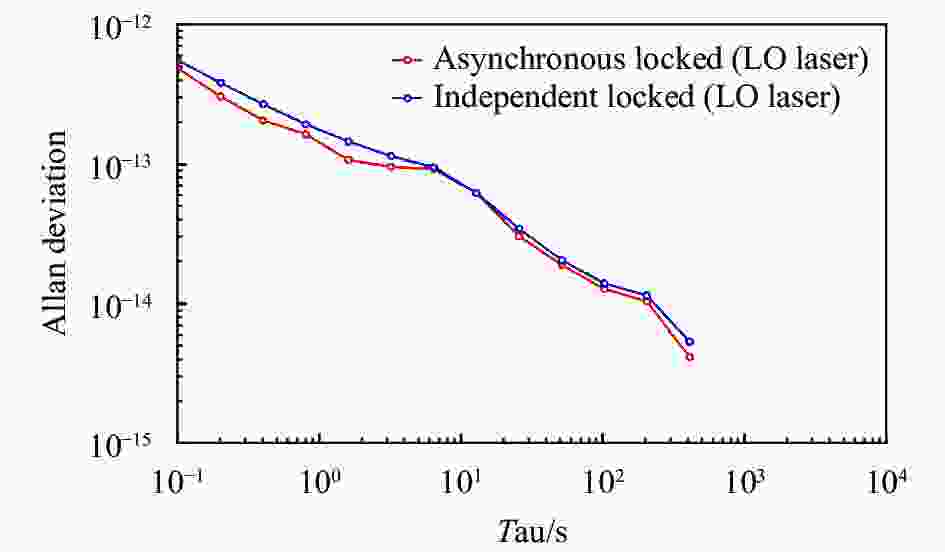

 DownLoad:
DownLoad:

